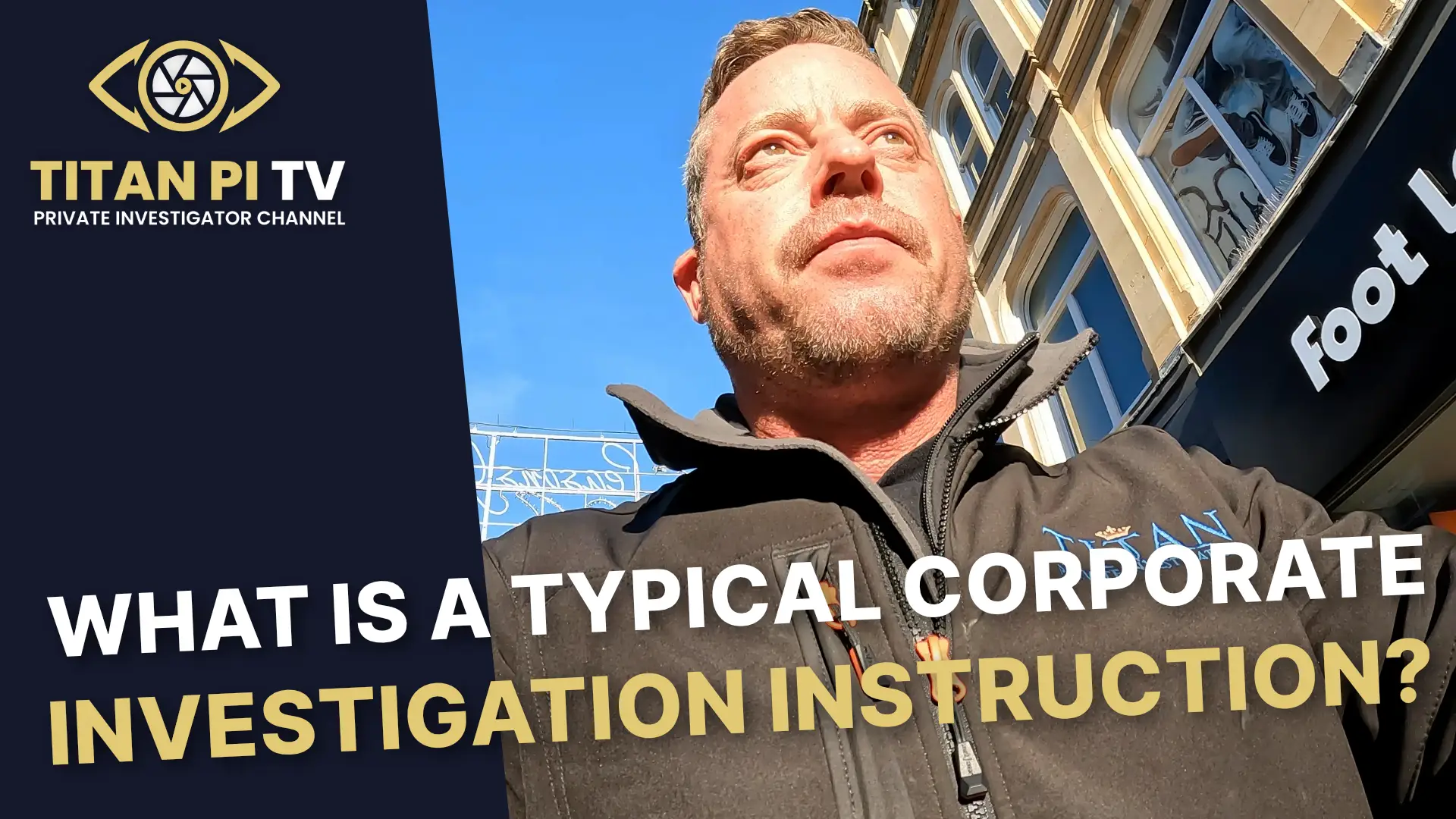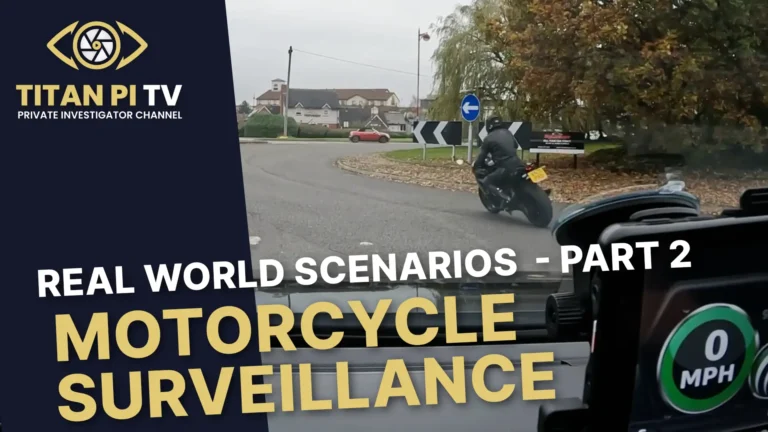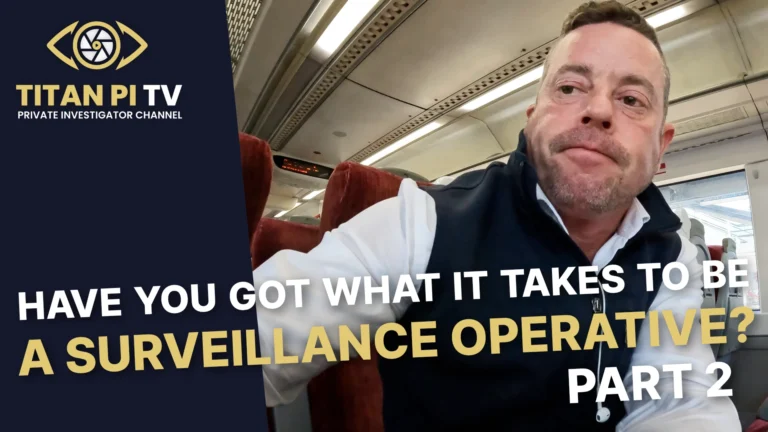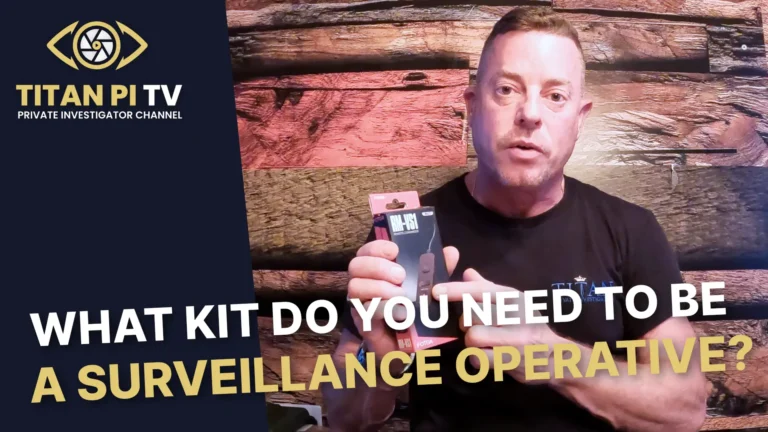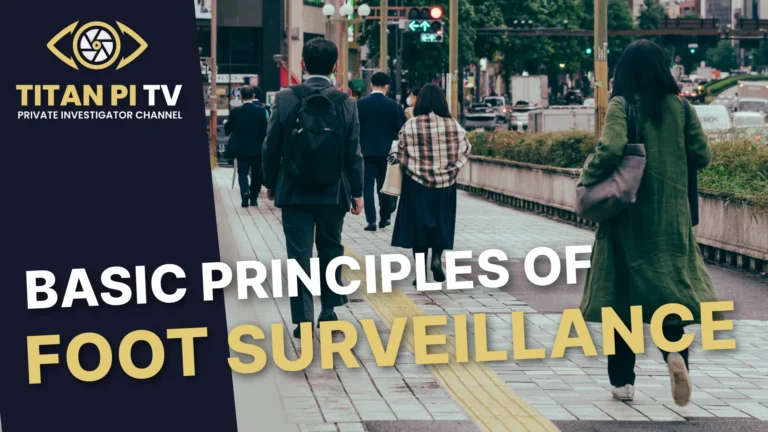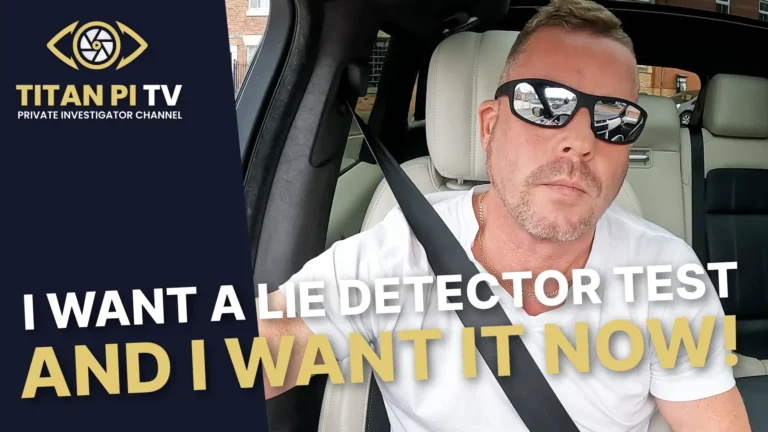What is a typical corporate investigation instruction?
Unveiling Corporate Surveillance: Simon Henson on Titan PI TV
In the latest episode of Titan PI TV, host and managing director of Titan Private Investigation Ltd, Simon Henson, lifts the lid on a side of business management that many company directors hope they never have to use, but increasingly do: corporate surveillance.
Broadcast from Titan’s Derby headquarters – one of 10 offices spanning England from Truro in the south-west to Manchester in the north-west – the episode, titled “What is a typical corporate investigation instruction?” explains when and why organisations instruct a private investigation agency, how a surveillance operation is run in practice, and what kind of evidence employers can expect at the end.
Henson, a seasoned investigator, is clear that when conducted lawfully and professionally, covert surveillance is a highly effective way for companies to establish the truth about suspected misconduct and protect their revenue.
Why Companies Turn to Corporate Surveillance
According to Henson, there are several recurring reasons why a business might approach Titan or another investigation firm with a corporate surveillance instruction. These include long‑term absenteeism, moonlighting, theft, intellectual property (IP) concerns and false expense claims.
These are not theoretical risks. Each has a direct financial and operational impact, and often a corrosive effect on staff morale.
Absenteeism and Exaggerated Injuries
One of the most common triggers is an employee who is off work following an accident, either at home or in the workplace.
In many cases, Henson explains, no one disputes that an accident occurred. The point of contention is whether the ongoing symptoms and claimed limitations genuinely reflect the employee’s capabilities.
“The accident is accepted,” he says, “but what is disputed is the effect of the accident and how it is affecting them – and whether they’re playing on it.”
An individual might be signed off with back problems, for example, claiming they cannot sit for long periods, drive, lift or perform particular duties. Over time, colleagues or managers may start to hear reports, or notice on social media, that the same person is engaging in activities that appear inconsistent with their stated restrictions.
The motivation for exaggerating symptoms can be financial – staying on full or enhanced sick pay – or simply the benefit of an extended break from work. Corporate surveillance, carefully planned and proportionate, gives employers a factual record of what the individual is doing day to day.
Moonlighting While on Sick Leave
Closely linked to absenteeism is “moonlighting”, a term Henson highlights as a growing problem for employers.
“Moonlighting is where an individual may be on the sick, so absenteeism once again, but working elsewhere and claiming statutory sick pay,” he explains.
Here, the employee is effectively double‑dipping: being paid by their main employer, who believes they are too unwell to work, while simultaneously earning from another job or their own business. This is not just a matter of poor ethics; it is a clear abuse of trust and a direct financial loss to the company footing the sick pay bill.
Henson recounts a recent Titan case that illustrates the issue starkly. An employee on a phased return to work, with reduced hours agreed due to an injury, was observed using their non‑working hours to run a physically demanding side business.
“They were on reduced hours, having a phased return to work,” he says. “However, those reduced hours, they were actually working elsewhere – their own business – which was a manual business: fencing. So they were putting fences up, but they weren’t able to do their job because it was manual.”
When surveillance footage shows an employee carrying heavy fence posts, digging holes and working at pace, while telling their employer they cannot perform far lighter duties, the contradiction is clear.
Theft of Company Assets
Theft remains a staple area for corporate investigations, and not all theft involves stock disappearing from a warehouse. Often, it is the misappropriation of company assets such as fuel, tools or equipment.
Henson describes a case involving a lorry driver. The driver was observed driving home in his company vehicle, then activating a siphoning system to remove diesel from the fuel tank once parked. That fuel was then allegedly used in his own vehicles or sold on for cash.
Over time, such behaviour can cost a business thousands of pounds in losses, especially in transport and logistics where fuel is a major expense. It also creates a culture in which others may feel tempted to copy the behaviour if they perceive it to be risk‑free.
Intellectual Property Theft
Beyond physical items, intellectual property is another area of concern. Titan has worked on instructions where an employer suspects that confidential information – pricing, customer lists, technical designs or strategic plans – is being passed to competitors.
Surveillance in these cases often forms part of a wider strategy that can also involve digital forensics and legal input. Covert observation can capture meetings, unrecorded handovers or suspicious visits that corroborate a pattern of IP leakage.
False Expense Claims
Finally, Henson points to false expenses as a persistent corporate headache. Employees may inflate mileage, invent client meetings or claim for trips that did not occur.
“We’ve had false expenses claims where we have followed the individual, or we’ve used tracking devices, and we’ve identified the expenses claimed are completely false,” he notes.
By surveilling the subject or tracking their vehicle and comparing actual movement with submitted claims, investigators can demonstrate whether the narrative in the expenses paperwork matches reality.
What a Typical Surveillance Instruction Looks Like
The episode does not stop at the reasons for surveillance. Henson walks viewers through what a typical corporate surveillance investigation instruction involves, from initial briefing to final report.
The Team: Never Just One Operative
A key point Henson makes is that professional surveillance is never a one‑person job.
“We deploy a minimum of two surveillance operatives,” he says. “It has to be a minimum of two; otherwise it’s one person in a car behind a subject, or one person on foot behind a subject – can’t be done.”
With only a single operative, the risk of losing the subject in traffic, being spotted, or being unable to react to sudden changes of direction is high. A two‑ or three‑person team can rotate positions, manage junctions and cover different routes without drawing undue attention.
The number of operatives – two as a minimum, sometimes three – depends on the specifics of the instruction and the likely complexity of the subject’s movements.
Time on Task: Minimum Five Consecutive Hours
Each deployment has a minimum operational window.
“Those operatives, they deploy for a minimum of five hours at a time. That’s five consecutive hours in a row,” Henson explains.
“So if the task is to start at 07:00 hours, the minimum deployment time would be five hours. They’d finish at midday. However, there is no maximum.”
In many corporate cases, Titan advises observing the employee for their full contracted working hours. If the employee is contracted from 9am to 5pm, for example, investigators will recommend continuous surveillance across that period.
“What we advise in these cases is that we watch the employee for the contracted hours,” Henson says. “If they work 9–5, we watch them between 9am and 5pm, because that is their contracted day.”
This approach gives a fair and representative picture of how the employee spends the full working day for which they are being paid.
Information Required from the Employer
Before the first vehicle leaves the office, Titan needs clear and accurate information from the instructing company. Henson sets out the basics:
- Start location – typically the employee’s home address or a known start point for the surveillance day.
- Associated vehicles – registration numbers, make, model and colour of any vehicles they may use.
- A recent image of the subject – to ensure positive identification on the ground.
With those details confirmed, the surveillance team is then able to deploy covertly, locate the subject and commence observation.
“We will then covertly follow them using the two or three operatives, record their movements throughout the day, and they will not know that they are being followed,” Henson explains.
From Fieldwork to Evidence: The Surveillance Report
The value of a surveillance instruction lies not just in following a subject, but in the quality of the evidence that is produced afterwards.
Covert Footage and Photographic Evidence
Throughout the operation, Titan’s operatives use covert camera systems to capture video footage of relevant activity. This can include:
- The subject’s physical capabilities (for example, lifting, carrying, driving, manual work)
- Places visited during contracted working hours
- Meetings or work undertaken that may conflict with stated sickness or company policies
Following the deployment, Titan compiles a detailed written report. This will usually include:
- A chronological account of the subject’s movements and actions
- Stills captured from the video footage to illustrate key events
- Time and date references for all significant observations
“Post‑deployment, we will then provide you with a comprehensive report which includes images taken from the surveillance footage,” Henson says. “We will give you the time–date stamped surveillance footage if required.”
Ready for Tribunal or Court
For many employers, a critical question is whether this material can be used formally if matters escalate.
Henson confirms that, when gathered lawfully and proportionately, surveillance evidence produced by Titan can be used in:
- Employment tribunals
- Family proceedings
- Criminal courts
- Civil courts
This means it can underpin disciplinary decisions, support dismissal for gross misconduct, assist in defending or bringing claims, and contribute to criminal prosecutions where appropriate.
A Direct Route to the Truth – and Cost Savings
Henson characterises corporate surveillance as one of the most straightforward and effective methods for establishing facts in contentious employment situations.
“Dead simple, dead effective,” he summarises. “The easiest way to get the truth is to use a surveillance team.”
For companies facing long and expensive absences, unexplained losses, repeated concerns about a particular employee or suspected abuse of trust, timely surveillance can prevent months of uncertainty and mounting costs.
“It’s going to save you as a company money,” he says, “and it’s going to get rid of those rogue employees who are effectively stealing your company revenue.”
Rogue employees, in this context, are not simply bending the rules. Whether it is fraudulent sick pay, stolen assets, leaked IP or falsified expenses, their actions directly erode profitability and can damage the wider culture of the organisation.
National Coverage from a Network of Offices
Although the episode is filmed in Derby, Henson is keen to emphasise Titan Private Investigation’s national reach. The firm operates 10 offices across England, from Truro in the south‑west to Manchester in the north‑west, providing comprehensive coverage.
“We cover all of England,” he notes. “We do go into Scotland and we do go into Wales, but our bread and butter is our 10 offices in England, giving us a national coverage.”
This network allows Titan to respond efficiently to instructions involving multiple locations, travelling employees or dispersed workforces, while still maintaining local knowledge and presence.
Taking the Next Step: Instructing Titan
For organisations considering their options, Henson’s message is simple: if you suspect corporate wrongdoing and need clarity, seek professional help rather than relying on rumours or informal checks.
“If you have a corporate investigation, please get in touch,” he says.
A typical engagement will begin with a confidential discussion to understand the concerns, assess whether surveillance is proportionate and lawful, and design an operation aligned with the company’s HR and legal framework.
Titan PI TV and Podcast: Educational Insight for Employers
The episode closes with Henson’s reminder that Titan PI TV is not just about showcasing the firm’s work, but about educating employers and the wider public on how professional investigations really operate.
For those who prefer audio, the content is also available as the Titan PI TV podcast, which can be downloaded from all major podcast platforms.
“If you like this episode, please give us a thumbs up – we love a thumbs up,” Henson says. “If you don’t want to miss further episodes then please subscribe to Titan PI TV on YouTube – it’s free.”
Signing off from Titan’s live operations environment, he leaves viewers with a familiar farewell that reflects the show’s weekly rhythm and approachable style:
“Hope you enjoyed it. Till next week – happy Friday.”
What’s Next on Titan PI TV?
Titan PI TV continues to grow steadily, with 3,032 subscribers and counting—a testament to the appetite for straight-talking guidance in a complex field. If you found Simon Henson’s insights useful, subscribe to the channel to catch future episodes. New content drops every Friday at 3:00 pm, offering grounded advice for investigators, agency owners, and professionals who work with them.
Thank you for reading, watching, or listening to this week’s blog post on Titan PI TV. For more expert advice and behind-the-scenes insights, subscribe to Titan PI TV on YouTube or download the Titan PI TV podcast wherever you get your podcasts. If you found this information helpful, please give us a thumbs up and subscribe to our channel. Stay tuned for more insights into the world of private investigations. Until next time, stay safe and keep learning!
Titan PI TV: Uncovering the Truth, One Investigation at a Time.

